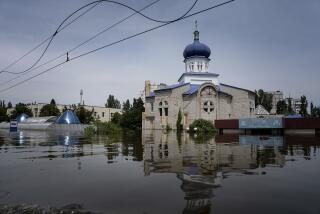Flowers Running Amok in African Lake
- Share via
PORT BELL, Uganda — Nature is running wild in Africa’s biggest lake.
Huge mats of the gauzy purple blossoms and thickly tangled roots of water hyacinths are mushrooming along the shores of Lake Victoria, disrupting life for millions of people.
The tangled masses of the aquatic weed strangle docks and clog waterworks. They block the flow of water into hydroelectric plants. They are even creeping onto school playgrounds.
Water hyacinths were introduced into Africa as ornamental plants a century ago, mostly likely in South Africa, and began spreading to new areas. Probably floating down the Kagera River from Rwanda, the plant appeared in Lake Victoria about a decade ago, and untreated sewage pouring into the lake fertilizes its rapid growth.
Profusion of water hyacinths is a problem in waterways in other parts of the world, such as the San Francisco Bay area and Florida and Japan and South Korea in Asia. But the cash-strapped governments of this region have limited resources and are struggling to tame the growth.
Photographs from U.S. surveillance satellites indicate about 1% of Lake Victoria’s surface--primarily along the shore--is now covered by water hyacinths, the popular name for Eichhornia crassipes. A U.S. Defense Department report warned that the rapid spread could harm the livelihoods of millions of people and cause instability in the East African region.
“The Department of Defense was sending out very distressed messages after seeing satellite images of the spread of the hyacinths on the lake,” said Luis Navarro, chief of a water hyacinth task force run by the Canadian-financed International Development Research Center.
Three nations, Uganda, Kenya and Tanzania, border Lake Victoria and depend on it for food, water, power and transportation.
The 26,830-square-mile lake, the size of Costa Rica, is the source of drinking water and hydroelectric power for 30 million people.
Hyacinth mats are blocking the flow of water into the electric turbines at Owens Falls Dam in Jinja, where the Nile River begins, causing power outages in much of Uganda. And the plants choke pumping stations, shutting off the flow of treated water to towns and cities.
Hundreds of thousands of people make their living directly from the lake, fishing for tilapia, Nile perch and dozens of other varieties that are sold either fresh or smoked and shipped to people inland. But fishermen often cannot get their dugout canoes and small boats through the tangle.
The lake’s big ferries sometimes struggle too. Port Bell used to be landlocked Uganda’s embarkation point for shipping coffee, tea and cotton for export overseas through the ocean port of Dar es Salaam in Tanzania. Today, most exports and imports must go through Jinja, 50 miles to the east, because masses of hyacinths besiege Port Bell.
And the problem isn’t confined to the lake.
In some places on the Kafue River in Zambia, four-mile-long mats of water hyacinths make the river impassable and tangles of the plant are threatening the power station that supplies the capital, Lusaka.
Dr. Thomas Sinkala of the University of Zambia said tons of hyacinths are crushing against the pillars of a key bridge over the Kafue, endangering the main road link from Zambia to South Africa.
One of the latest entries in the war on the hyacinths is Aquatics Unlimited of Martinez, Calif., a company with 20 years of experience in fighting aquatic weeds in the U.S. and Asia.
After reading about Lake Victoria’s problem a year ago, Aquatics president Tom McNabb proposed his company’s services to Ugandan officials.
“They were real skeptical because of earlier fiascoes,” McNabb said, ripping up a handful of hyacinths from the mud at Port Bell.
Next to him stood an abandoned, $275,000 contraption that was meant to gobble up the plants and spew them out. The European Union-financed prototype failed on its trial run.
But after hearing support from the U.S. government, Uganda accepted the proposal from McNabb and his partner, the University of Florida Center for Aquatic Plants.
McNabb said total eradication is not possible, so the aim of the program is to reduce plant infestations and maintain them at a level that can be controlled.
The campaign is three-pronged: spraying herbicides to kill plants; using mechanical choppers and excavators to reduce plant masses; and putting out beetles to eat the hyacinth leaves.
Each of the methods has its drawbacks. Herbicides can adversely affect aquatic life and drinking water and must be constantly monitored. Choppers and harvesters can get bogged down in the dense plant mass. The beetles, although they eat much of the foliage, do not significantly reduce the mass.
The program is projected to cost $5.5 million, with the U.S. Agency for International Development providing a $1-million grant.
For now, Ugandans rely on human power.
At Port Bell, five miles south of Uganda’s capital, Kampala, men struggle with picks and shovels to tear water hyacinths out of the muck. The concrete pier is cracked from the pressure of the matted plants being crushed against the quay when passenger and cargo boats try to dock.
“When the wind blows them away for a while, you would not believe there is a problem,” port officer Paul Lechi said of the plants. “But when they come back, the boats smash them against the quay, and it breaks.”
More to Read
Sign up for Essential California
The most important California stories and recommendations in your inbox every morning.
You may occasionally receive promotional content from the Los Angeles Times.













